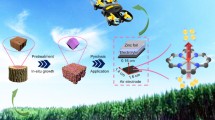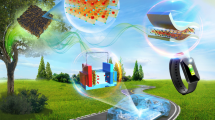Abstract
It is of great significance to enhance mass transfer and improve active surface area in cathodes for zinc–air batteries (ZABs), which promote oxygen reduction reaction (ORR) efficiency and power outputs. Nature has endowed some tissues with special structures to have efficient mass transfer properties and high active surface area. As an important mass transfer part of trees, xylem contains massive long and partially aligned channels, which provides numerous “passageway” and high active surface area for plants to facilitate the efficient transport of oxygen and inorganic salts. The multi-channel structures give an important insight to develop high efficient air cathode. Herein, 3D-printed bio-inspired multi-channel cathodes (BMCs), inspired by xylem structures, have been developed for high-performance ZABs via 3D printing. Channels of bionic cathode contribute to forming a continuous supply of oxygen from air. As a result, massive tri-phase boundary regions, where ORR happens, are formed inside of cathode. Moreover, the 3D-printed metal-based framework can facilitate electron transfer during ORR process. Benefiting from the multi-channel framework, the assembled ZABs with BMC-600 show excellent electrochemical performances in terms of the high power density of 170.1 mW cm−2 and a high open-circuit voltage of 1.51 V. Therefore, BMCs provide a potential alternative as promising cathode for metal–air batteries.




Similar content being viewed by others
References
Steele, B. C. H., & Heinzel, A. (2001). Materials for fuel-cell technologies. Nature, 414, 345–352.
Xia, W., Mahmood, A., Liang, Z. B., Zou, R. Q., & Guo, S. J. (2016). Earth-abundant nanomaterials for oxygen reduction. Angewandte Chemie International Edition, 18, 2650–2676.
Li, Y., & Dai, H. (2014). Recent advances in zinc–air batteries. Chemical Society Reviews, 43, 5257–5275.
Wang, S. Y., Chen, S. M., Ma, L. T., & Zapien, J. A. (2021). Recent progress in cobalt-based carbon materials as oxygen electrocatalysts for zinc-air batteries applications. Materials Today Energy, 20, 100659–110689.
Masa, J., Xia, W., Muhler, M., & Schuhmann, W. (2015). On the role of metals in nitrogen-doped carbon electrocatalysts for oxygen reduction. Angewandte Chemie International Edition, 54, 10102–10120.
Nørskov, J. K., Rossmeisl, J., Logadottir, A., Lindqvist, L., Kitchin, J. R., Bligaard, T., & Jónsson, H. (2004). Origin of the overpotential for oxygen reduction at a fuel-cell cathode. Journal of Physical Chemistry B, 108, 17886–17892.
Wu, G., More, K. L., Johnston, C., & Zelenay, P. (2011). High-performance electrocatalysts for oxygen reduction derived from polyaniline, iron, and cobalt. Science, 332, 443–447.
Greeley, J., Stephens, I. E. L., Bondarenko, A. S., Johansson, T. P., Hansen, H. A., Jaramillo, T. F., Rossmeisl, J., Chorkendorff, I., & Nørskov, J. K. (2009). Alloys of platinum and early transition metals as oxygen reduction electrocatalysts. Nature Chemistry, 1, 552–556.
Zhu, A. Q., Qiao, L. L., Tan, P. F., Ma, Y. J., Zeng, W. X., Dong, R., Ma, C., & Pan, J. (2019). Iron-nitrogen-carbon species for oxygen electro-reduction and Zn–air battery: Surface engineering and experimental probe into active sites. Applied Catalysis B: Environmental, 254, 601–611.
Zhang, F., Saito, T., Cheng, S. A., Hickner, M. A., & Logan, B. E. (2010). Microbial fuel cell cathodes with poly(dimethylsiloxane) diffusion layers constructed around stainless steel mesh current collectors. Environmental Science & Technology, 44, 1490–1495.
Wang, Y., Kong, A. G., Chen, X. T., Lin, Q. P., & Feng, P. Y. (2015). Efficient oxygen electroreduction: Hierarchical porous Fe-N-doped hollow carbon nanoshells. ACS Catalysis, 5, 3887–3893.
Yao, Y. F., You, Y., Zhang, G. X., Liu, J. G., Sun, H. R., Zou, Z. G., & Sun, S. H. (2016). Highly functional bioinspired Fe/N/C oxygen reduction reaction catalysts: Structure-regulating oxygen sorption. ACS Applied Materials & Interfaces, 8, 6464–6471.
Berlyn, G. P. (1983). Plant structures: Xylem structure and the ascent of sap. Science, 222, 500–501.
Tyree, M. T., & Zimmermann, M. (2002). H. Xylem structure and the ascent of sap. Springer.
Aleksandra, S., Alicja, D., & Katarzyna, S. (2021). Xylem parenchyma-role and relevance in wood functioning in trees. Plants, 10, 1247–1271.
Craig, R. B., Adam, B. R., Jay, W. W., & Andrew, J. M. (2019). Functional status of xylem through time. Annual Review of Plant Biology, 70, 407–433.
Shen, F., Luo, W., Dai, J. Q., Yao, Y. G., Zhu, M. W., Emily, H., Tang, Y. F., Chen, Y. F., Sprenkle, V. L., Li, X. L., & Hu, L. B. (2016). Ultra-thick, low-t ortuosity, and mesoporous wood carbon anode for high-performance sodium-ion batteries. ACS Applied Energy Materials, 6, 1600377–1600383.
Yang, Y., Sun, X., Cheng, Z., Alolika, M., Avi, N., Liu, C., Cao, D. X., & Zhu, H. L. (2020). Functionalized well-aligned channels derived from wood as a convection-enhanced electrode for aqueous flow batteries. ACS Applied Energy Materials, 3, 6249–6257.
Song, H. Y., Xu, S. M., Li, Y. J., Dai, J. Q., Gong, A., Zhu, M. W., Zhu, C. L., Chen, C. J., Chen, Y. N., Yao, Y. G., Liu, B. Y., Song, J. W., Pastel, G., & Hu, L. B. (2018). Hierarchically porous, ultrathick, “breathable” wood-derived cathode for lithium-oxygen batteries. ACS Applied Energy Materials, 8, 1701203–1701210.
Lyu, L. L., Seong, K. D., Ko, D. J., Choi, J. Y., Lee, C. D., Hwang, T. J., Cho, Y. S., Jin, X. Z., Zhang, W., Pang, H., & Piao, Y. Z. (2019). Recent development of biomass-derived carbons and composites as electrode materials for supercapacitors. Materials Chemistry Frontiers, 3, 2543–2570.
Sun, J. M., Wu, Z. W., Ma, C. H., Xu, M. C., Luo, S., Li, W., & Liu, S. X. (2021). Biomass-derived tubular carbon materials: Progress in synthesis and applications. Journal of Materials Chemistry A, 9, 13822–13850.
Gannon, P. E., Tripp, C. T., Knospe, A. K., Ramana, C. V., Deibert, M., Smith, R. J., Gorokhovsky, V. I., Shutthanandan, V., & Gelles, D. (2004). High-temperature oxidation resistance and surface electrical conductivity of stainless steels with filtered arc Cr-Al-N multilayer and/or superlattice coatings. Surface & Coatings Technology, 188, 55–61.
Celiktas, M. S., & Alptekin, F. M. (2019). Conversion of model biomass to carbon-based material with high conductivity by using carbonization. Energy, 188, 116089–116099.
Berman, B. (2013). 3D printing: The new industrial revolution. IEEE Engineering Management Review, 41, 72–80.
Lipson, H. (2013). Fabricated: The new world of 3D printing. Wiley publishing.
Gross, B. C., Erkal, J. L., Lockwood, S. Y., Chen, C., & Spence, D. M. (2014). Evaluation of 3D printing and its potential impact on biotechnology and the chemical sciences. Analytical Chemistry, 86, 3240–3253.
Zhang, J., Li, X. L., Fan, S., Huang, S. Z., Yan, D., Liu, L., Pablo, V. Y. A., & Yang, H. Y. (2020). 3D-printed functional electrodes towards Zn–Air batteries. Materials Today Energy, 16, 100407–100412.
Wei, C. H., Tian, M., Wang, M. L., Shi, Z. X., Yu, L. H., Li, S., Fan, Z. D., Yang, R. Z., & Sun, J. Y. (2020). Universal in situ crafted MOx-mxene heterostructures as heavy and multifunctional hosts for 3D-printed Li-S batteries. ACS Nano, 14, 16073–16084.
Fan, Z. D., Jin, J., Li, C., Cai, J. S., Wei, C. H., Shao, Y. L., Zou, G. F., & Sun, J. Y. (2021). 3D-printed Zn-ion hybrid capacitor enabled by universal divalent cation-gelated additive-free Ti3C2 mxene ink. ACS Nano, 15, 3098–3107.
Guo, T. Q., Song, Y. Z., Sun, Z. T., Wu, Y. H., Xia, Y., Li, Y. Y., Sun, J. H., Jiang, K., Dou, S. X., & Sun, J. Y. (2020). Bio-templated formation of defect-abundant VS2 as a bifunctional material toward high-performance hydrogen evolution reactions and lithium-sulfur batteries. Journal of Energy Chemistry, 42, 34–42.
Ye, G. Y., He, Q., Liu, S. Q., Zhao, K. M., Su, Y. K., Zhu, W. W., Huang, R. J., & He, Z. (2019). Cage-confinement of gas-phase ferrocene in zeolitic imidazolate frameworks to synthesize high-loading and atomically dispersed Fe–N codoped carbon for efficient oxygen reduction reaction. Journal of Materials Chemistry A, 7, 16508–16515.
Yuan, K., Lu, C. B., Sfaelou, S., Liao, X. X., Zhuang, X. D., Chen, Y. W., Scherf, U., & Feng, X. L. (2019). In situ nanoarchitecturing and active-site engineering toward highly efficient carbonaceous electrocatalysts. Nano Energy, 59, 207–215.
Shou, D. H., & Fan, J. T. (2018). Design of nanofibrous and microfibrous channels for fast capillary flow. Langmuir the ACS Journal of Surfaces & Colloids, 34, 1235–1241.
Andersson, J., Ström, A., Gebäck, T., & Larsson, A. (2017). Dynamics of capillary transport in semi-solid channels. Soft Matter, 13, 2562–2570.
Sekhon, S. S., & Park, J. S. (2021). Biomass-derived N-doped porous carbon nanosheets for energy technologies. Chemical Engineering Journal, 425, 129017–129035.
Titirici, M. M., White, R. J., Falco, C., & Sevilla, M. (2012). Black perspectives for a green future: Hydrothermal carbons for environment protection and energy storage. Energy & Environmental Science, 5, 6796–6822.
Kanaan, A., Mazloum, A., & Sevostianov, L. (2016). On the connections between plasticity parameters and electrical conductivities for austenitic, ferritic, and semi-austenitic stainless steels. International Journal of Engineering Science, 105, 28–37.
Han, J. X., Meng, X. Y., Lu, L., Bian, J. J., Li, Z. P., & Sun, C. W. (2019). Single-atom Fe–Nx–C as an efficient electrocatalyst for zinc-air batteries. Advanced Functional Materials, 29, 1808872–1808879.
Sheng, S. Y., Shi, B. R., Wang, C., Luo, L., Lin, X., Li, P. S., Chen, F. H., Shang, Z. C., Meng, H., Kuang, Y., Lin, W. F., & Sun, X. L. (2020). Anti-buoyancy and unidirectional gas evolution by janus electrodes with asymmetric wettability. ACS Applied Materials & Interfaces, 12, 23627–23634.
Acknowledgements
This work was supported by the National Natural Science Foundation of China (51975245 and 52075214), Jilin Provincial Science & Technology Department (20200201058JC, 20190303039SF and 20200201224JC), Department of Jilin Provincial Education (JKH20210884KJ), Key Science and Technology R&D Projects of Jilin Province (2020C023-3), Program of Jilin University Science and Technology Innovative Research Team (2020TD-03), and Youth Development Program of Jilin University (2020-JCXK-22).
Author information
Authors and Affiliations
Corresponding authors
Ethics declarations
Conflict of interest
The authors declare that they have no known competing financial interests or personal relationships that could have appeared to influence the work reported in this paper.
Additional information
Publisher's Note
Springer Nature remains neutral with regard to jurisdictional claims in published maps and institutional affiliations.
Supplementary Information
Below is the link to the electronic supplementary material.
Rights and permissions
About this article
Cite this article
Men, X., Li, Z., Yang, W. et al. 3D-Printed Bio-inspired Multi-channel Cathodes for Zinc–air Battery Applications. J Bionic Eng 19, 1014–1023 (2022). https://doi.org/10.1007/s42235-022-00173-5
Received:
Revised:
Accepted:
Published:
Issue Date:
DOI: https://doi.org/10.1007/s42235-022-00173-5




